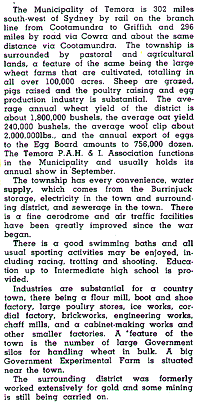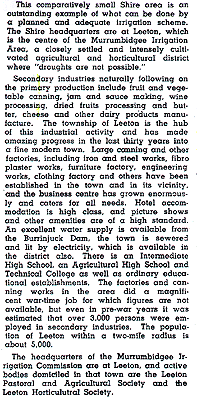Temora is 325 km. west of Sydney, 90 km. north of Wagga Wagga and in the north-east of the Riverina district.
Temora was the name of an early pastoral property, and was derived from an Aboriginal word of uncertain meaning or from a Scottish Gaelic tern meaning an eminence with an extensive view. The Temora pastoral station was gazetted in 1849, occupying 200,000 acres.
Unpayable quantities of gold were found on the Temora station in 1869, and the discovery of payable gold did not occur until 1880. A small village formed by April, 1880. By the middle of 1880 there were 20,000 people in the Temora district and the town site was surveyed. The next few years saw the winning of gold (alluvial and reef) and prolonged drought. By 1885 Temora had a hospital and three churches. In 1888 most of the Temora station was subdivided for small-farm settlement. Three years later the Temora town council was created and the railway reached Temora in 1897. A well-established Temora was described in The Australian Handbook, 1904, as –

In 1912 the town electricity supply was established and an agricultural research station opened. It concentrated on pasture, wheat and oat growing and sheep research. On the eve of the first world war the Star Theatre was opened and in 1925-6 the Literary Institute and School of Arts were opened. The benefits of the Burrinjuck Dam on the Murrumbidgee River, 120 km. to the east came in 1930 with the supply of hydro electricity and in 1935 with a town water supply. The swimming pool was opened in the same year, and a sewerage scheme built four years later.
Temora, with a municipal area of 21 sq. km. was described in the 1949 edition of The Australian Blue Book as –

In 1952 the Temora High School was opened and in 1971 a large pre-school premises was built. A reduction in secondary industry (the cordial factory closed in 1979) was partially relieved by tourism and the town’s historical society embarking on a rural museum in 1979. An extensive group of buildings was acquired, including Sir Donald Bradman’s original home. The township also contains several substantial buildings, a notable one being the Sacred Heart Catholic Church.
In 1969, on the property of harness-racing horse breeder, Colin Pike, a colt named Paleface Adios was born. The horse became the Pharlap of harness racing over an eight year career that ended in 1980. Temora has a memorial to “The Temora Tornado, Paleface Adios.” In 1981 the councils of Temora (town) and the surrounding Narraburra shire were united to from the Temora shire of 3,752 sq. km. The district’s gold mining past was revived when the Paragon open-cut gold mine was begun in 1987, about 12 km. north of Temora at Gidginbung. Temora has seven hotels and one hotel/motel. In 1994 the Temora shire had 120,494 ha. under pasture, 34,683 ha. growing wheat and 574,000 sheep and lambs.
Temora’s census populations have been 2,784 (1911), 3,823 (1931), 4,446 (1971) and 6,200 (1991 – enlarged shire). The town’s 1991 population was 4,279.
Further Reading:
- Goffin, Graham, Paleface Adios, The Living Legend, Harness Racing Publications, 1982.
- Temora Yesterday and Today 1880-1980, Temora Historical Society Inc., 1992.






